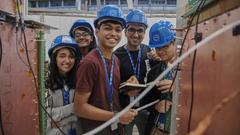High-school students at this year's competition. Image: CERN
It’s 9 a.m. and the control room is a hive of activity. Researchers have just finished their daily morning meeting and are getting about the tasks they set themselves. Some discuss the quality of yesterday’s data, others get ready to enter the beamline where their experiment is set up to make a few adjustments, another group checks the beam monitors for the status of the accelerator that provides them with a particle beam. Just a normal day at a test beam experiment at CERN… but wait. These researchers are 16 years old. They have swapped their classrooms with the control room for a unique project: Beamline for Schools, an international competition initiated in 2014 by CERN. In 2019, the Beamline for Schools competition is coming to DESY! Check the video for details.
Beamline for Schools offers high-school students a taste of what life as a researcher is really like, including proposal writing, safety training, data taking and analysis of their results. In its sixth year the competition will move from CERN to DESY because CERN’s accelerators are shutting down for a two-year upgrade break. Even if the particles are different DESY’s test beam facilities provide similar conditions as those at CERN, which is why the two labs teamed up to continue the project. “We are really looking forward to hosting the competition in 2019,” says DESY Test Beam Coordinator Marcel Stanitzki. “It’s a truly unique experience for the students and we are already curious what kind of creative science ideas they come up with.”
When Beamline for Schools started in 2014, it had been conceived as a one-off project during CERN’s 60thanniversary year. Its success meant it went into year two and has since been tuned into an annual event. To this day more than 900 teams representing a total of some 8500 students from 76 countries worldwide have submitted proposals for experiments they want to carry out at a beamline. Financial support comes from the CERN and Society Foundation, supported by individual donors, foundations and companies.
The procedure is as simple as it is challenging: high-school students tickled by the idea of working as real scientists form teams of at least five students and at least one adult coach. They come up with an idea of an experiment that could be done using particles from a beamline and the equipment provided by CERN and DESY. National contacts stand ready to help answer questions. There is no limit to creativity – only to the safety and feasibility of the experiments. The groups can pre-register their team as a first step before they submit their proposal until 31 March 2019. The proposal is a written text of up to 1000 words and a one-minute video explaining the experiment and introducing the team members.
Scientists, engineers, educators and communicators then evaluate the proposals for feasibility, scientific method, motivation of the experiment and the creativity of both the experiment and thevideo. Finally two teams get selected and win an all-expenses-paid trip to DESY. Up to 30 shortlisted teams win a BL4S T-shirt for each team member and other cool prizes, all others receive a certificate of participation .
And then for the 2019 edition fun starts in October at DESY… up to 18 students plus their coaches will be staying in the DESY guest house, get their proper safety equipment and safety training, learn about DESY, science and how it is done and eventually work just like scientists performing their proposed experiments. Experts from DESY and CERN will be working hand in hand with the students. There will also be time for cultural activities and exploring the city.
“The competition is not only about attracting new talent to science or introducing students to the world of research – it is also about learning new skills and broadening students’ minds,” explains the BL4S Programme Manager Sarah Aretz from CERN. “Not only the winning teams gain from this experience. We have received a lot of positive feedback from participating students and teachers telling us what a valuable experience taking part in this competition has been.”
Previous winning teams have tested their classroom-grown crystals in the beamline as a calorimeter in order to see whether this can be done and used at school (it can, and these students have published a scientific paper on their findings), suggested muon radiography for pyramids, searched for exotic particles, measured the Bragg peak of hadrons and much more. Proposals were sent in for the testing of spacecraft shielding to protect astronauts from cosmic radiation, the analysis of the atmosphere with respect to greenhouse gases or the translation of signals of elementary particles into art. Would you like to take part? Just build a team, sign up and maybe become a scientist for two weeks!
If you would like to know more, check out the project homepage. There are many helpful documents, national contacts to help you in your language, information on past editions, and much more.
Watch this video to lean more: Beamline for Schools 2019








